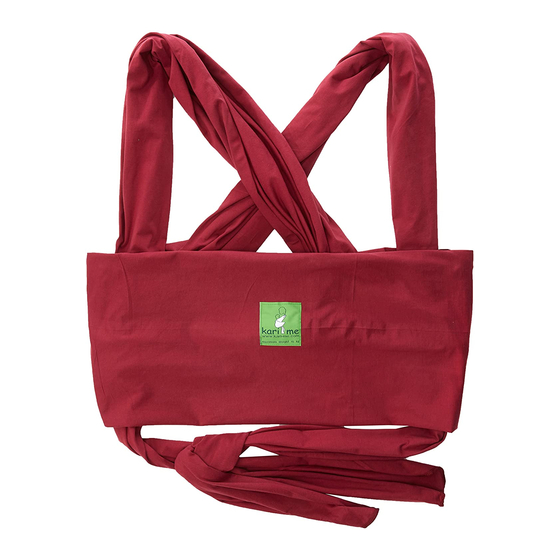
Advertisement
Advertisement
Table of Contents

Summary of Contents for Kari Me Baby Wrap
- Page 1 ® Baby Carrier Instruction Booklet w w w . k a r i - m e . c o m...
- Page 2 We are delighted that you have decided to purchase this Kari Me and join the growing group of parents and carers who have chosen to carry their babies using our soft carrier. The western world has relatively recently started re-discovering the benefits of carrying babies close to the carer’s body.
- Page 3 The carer’s hands are free and they can continue their daily activities and chores, such as shopping, attending to other children etc. The Kari Me makes daily travelling with a baby smooth and easy ● and is especially useful for holiday travel.
- Page 4 ● Kari Me has better weight distribution than most other carriers, with more weight supported by the waist near the centre of gravity, releasing pressure from the back and shoulders. This is physically beneficial for new mothers, whose body is still vulnerable after birth.
- Page 5 Your balance may be adversely affected due to movement of you and your child. ● Take great care when bending or leaning forward. ● Do not go to sleep while wearing your baby in Kari Me baby carrier. continued on page 6...
- Page 6 Warning WASHING INSTRUCTIONS Kari Me ● This carrier is not suitable for sports activities. You can wash your in a washing machine at ● To avoid the risk of suffocation: keep the carrier bag away 30°C - 40°C from babies and small children. Do not let your baby or toddler play with the carrier.
- Page 7 TIP If you travel by car, wear the Kari Me at home before leaving. On arrival, all you have to do is simply take the baby out of the car seat and place them into the Kari Me.
- Page 8 Cuddly This position can be used from baby’s birth and it is ideal for sleeping or breast-feeding. The Cuddly position will give the young baby all the warmth and surrounded feeling he requires at these initial stages. Start by applying the basic knot and then follow the instructions step by step. Slide the Using both hands spread the Carefully...
- Page 9 Cuddly Follow these instructions to complete the Cuddly position. Note: a baby should never be curled so their chin is forced onto their chest as. Spread the Stretch the NOTES fabric over the fabric strap ● To achieve the best position for breast feeding take the baby’s lower baby and your with the logo arm out of the carrier, between your arm and the side of your body.
- Page 10 Huggy (Tummy to Tummy) This position can be used from birth. When using this position at an early age (before the baby can support his head properly) the baby’s head must be always supported by the fabric. The position is suitable for moving around with your baby and while putting him to sleep. Start by applying the basic knot and then follow the instructions step by step.
- Page 11 Huggy (Tummy to Tummy) Follow these instructions to complete the Huggy (Tummy to Tummy) position. Important For younger babies, Spread the fabric Stretch the fabric strap with wide underneath the logo over the baby to use one of the shoulder straps to baby to create a nice, achieve the final position.
- Page 12 Baby faces the World This position can be used when your baby has reached the stage where he can support and turn his head freely to the sides. Start by applying the basic knot and then follow the instructions step by step. It is recommended to limit the carry in this position for up to 30-40 minutes at a time.
- Page 13 Side Position This position is suitable for babies from 6 months old and is good for older toddlers as well. This hip carrying position allows the baby to explore the world while feeling close to his parent. Unlike other slings, the baby’s weight is distributed across both shoulders, back and waist. Instructions: Follow the instructions on page 10-11 to achieve the Huggy position.
- Page 14 T.I.C.K.S. Rule for Safe Babywearing ight n view at all times lose enough to kiss eep chin off the chest upported back Tight – slings and carriers should be tight enough to hug your baby close to you as this will be most comfortable for you both. Any slack/loose fabric will allow your baby to slump down in the carrier which can hinder their breathing and pull on your back.
- Page 15 Close enough to kiss – your baby’s head should be as close to your chin as is comfortable. By tipping your head forward you should be ab le to kiss your baby on the head or forehead. Keep chin off the chest – a baby should never be curled so their chin is forced onto their chest as this can restrict their breathing.
- Page 16 ® Baby Carrier Instruction Booklet Distributed by Robin’s Textiles Ltd Customer Care +44 115 933 5566 www.kari-me.com...
Need help?
Do you have a question about the Baby Wrap and is the answer not in the manual?
Questions and answers